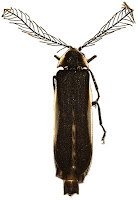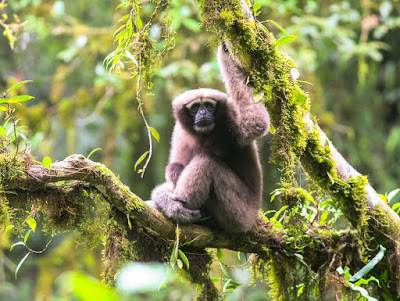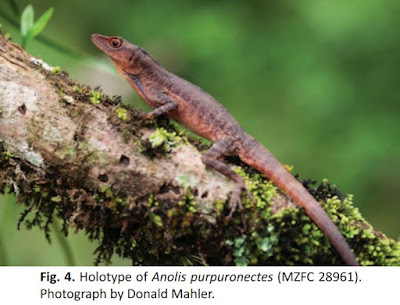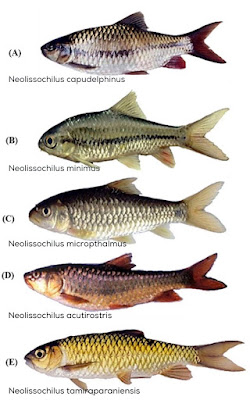[Most Recent Entries] [Calendar View]
Tuesday, January 17th, 2017
| Time | Event | ||||
| 3:18a | [Entomology • 2017] Araucariocladus hiems • A New Tropical Montane Firefly Genus and Species (Coleoptera: Lampyridae), Active During Winter and Endemic to the southeastern Atlantic Rainforest
Abstract Here we describe Araucariocladus hiems gen. et sp. nov. (Lampyridae: Amydetinae), a firefly species endemic to high montane forests, and occurring during June, a relatively cool and dry month in the Southeastern Atlantic Rainforest of Brazil. We tentatively place it in Psilocladina McDermott, and discuss the limitations of its classification. We also provide illustrations of key structural features of the new taxa and discuss its affinities. Keywords: Coleoptera, Endemism, Psilocladina, Serra dos Órgãos, tropical winter Luiz Felipe Lima Da Silveira and Jose Ricardo Miras Mermudes. 2017. A New Tropical Montane Firefly Genus and Species, Active During Winter and Endemic to the southeastern Atlantic Rainforest (Coleoptera: Lampyridae). Zootaxa. 4221(2); 205–214. DOI: 10.11646/zootaxa.4221.2.4 | ||||
| 9:46a | [Mammalogy • 2017] Hoolock tianxing • A New Species of Hoolock Gibbon (Primates: Hylobatidae), based on Integrative Taxonomy, from eastern Myanmar and southwestern China
Abstract We describe a species of Hoolock gibbon (Primates: Hylobatidae) that is new to science from eastern Myanmar and southwestern China. The genus of hoolock gibbons comprises two previously described living species, the western (Hoolock hoolock) and eastern hoolock (H. leuconedys) gibbons, geographically isolated by the Chindwin River. We assessed the morphological and genetic characteristics of wild animals and museum specimens, and conducted multi-disciplinary analyses using mitochondrial genomic sequences, external morphology, and craniodental characters to evaluate the taxonomic status of the hoolock population in China. The results suggest that hoolocks distributed to the east of the Irrawaddy-Nmai Hka Rivers, which were previously assigned to H. leuconedys, are morphologically and genetically distinct from those to the west of the river, and should be recognized as a new species, the Gaoligong hoolock gibbon or skywalker hoolock gibbon (Hoolock tianxing sp. nov.). We consider that the new species should be categorized as Endangered under IUCN criteria. The discovery of the new species focuses attention on the need for improved conservation of small apes, many of which are in danger of extinction in southern China and Southeast Asia.
Order Primates Linnaeus (1758) Family Hylobatidae Gray (1870) Genus Hoolock Mootnick and Groves (2005) Hoolock tianxing sp. nov. Hylobates hoolock leuconedys: Groves (1967): 276 (part). Skywalker Hoolock Gibbon or Gaoligong Hoolock Gibbon Holotype: AMNH M-43068 (adult male, skin only; Figure 3), collected by Roy Chapman Andrews and Yvette Borup Andrews on April 5, 1917 during the American Museum of Natural History's Asiatic Zoological Expedition (Allen, 1938). Type locality: Ho-mu-shu (=Hongmushu) Pass, Baoshan, Yunnan, China (25.00 N, 98.83 E). Paratypes: AMNH M-43065 (adult female, skin only; Supplemental Figure S1) and MCZ 26474 (=AMNH M-43067, skin and skull, relocated to MCZ in September 1930), collected at the same locality as the holotype (Allen, 1938). IOZ 25965 (adult male, skin and skull; Supplemental Figure S3), collected on 4 June, 1965 at Tengchong, Yunnan, China. MCZ 30383 (adult male, skin and skull; Supplemental Figure S3) collected on 15 January, 1932, ca. 40 miles east of Bhamo, northern Myanmar, during the Brooke Dolan expedition. Etymology: Tianxing, meaning heaven's movement or skywalker (xing, movement, can act as either a noun or a verb), a name referring to the unique locomotory mode of gibbons (brachiation; Figure 8) and derived from the text of the I Ching, an ancient Chinese work of divination (“As heaven's movement is ever vigorous, so must the scholarly gentleman (ajp22631-gra-0005, “junzi”) ceaselessly strive for self-improvement”). Gibbons were widely regarded as a symbol of scholar-officials or junzi in ancient China, as the perceived “noble” characteristics of gibbons were considered to accord with the aesthetic taste of both Daoism and traditional Chinese scholars (van Gulik, 1967; Ye & Heule, 2013). Diagnosis: Hoolock tianxing is a hoolock gibbon distinguished from other described hoolock species by a combination of external and dental characters. In males, the ventral pelage is brownish, resembling that of H. leuconedys but differing from H. hoolock. The eyebrows are relatively thinner than in H. hoolock and H. leuconedys, and well-separated, differing from the condition in H. hoolock, where there is only a narrow gap between the eyebrows. White hairs are absent in the suborbital area, differing from H. leuconedys, which has white hairs in the suborbital area. The beards of males are black or brown, differing in color from H. leuconedys, which has a whitish or buffy beard, and not as prominent as in H. hoolock. The black, brown or grayish genital tuft in males differs in color from H. leuconedys, which has a white or silvery tuft. The face rings in females are incomplete, differing from the condition in both H. hoolock and H. leuconedys. The crown outline of the lower p4 is oval, making it distinct from H. leuconedys and H. hoolock individuals from Myanmar and more similar to H. hoolock from Assam. Distribution: Between the Irrawaddy-Nmai Hka River and the Salween River in China and Myanmar. The Dulongjiang valley, the upper tributary of the Nmai Hka River, may serve as a dispersal barrier for hoolocks. Wild individuals are confirmed to occur on Mt. Gaoligong, and historical museum specimens are also known from further south at Gokteik, Shan State, northern Myanmar. Geissmann et al. (2013) estimated that a healthy population with ca. 50,000 individuals of eastern hoolock live in Shan State subtropical forests, and ca. 16,000 individuals live in montane rainforest in Kayah-Kayin. Peng-Fei Fan, Kai He, Xing Chen, Alejandra Ortiz, Bin Zhang, Chao Zhao, Yun-Qiao Li, Hai-Bo Zhang, Clare Kimock, Wen-Zhi Wang, Colin Groves, Samuel T. Turvey, Christian Roos, Kristofer M. Helgen and Xue-Long Jiang. 2017. Description of A New Species of Hoolock Gibbon (Primates: Hylobatidae) Based on Integrative Taxonomy. American Journal of Primatology. DOI: 10.1002/ajp.22631 New species of gibbon discovered in China TheGuardian.com/environment/2017/jan/11/n | ||||
| 9:48a | [Herpetology • 2016] Anolis purpuronectes • A New Species of Semiaquatic Anolis (Squamata: Dactyloidae) from Oaxaca and Veracruz, Mexico Abstract We describe a new species of semiaquatic Anolis (Anolis purpuronectes) from the Chimalapas region of eastern Oaxaca and adjacent Veracruz, Mexico, and investigate its phylogenetic relationships with the closely related species A. barkeri to which the populations under investigation have previously been assigned to. Anolis barkeri and the new species appear to be allopatric, and differ primarily in male dewlap colour (red and orange in A. barkeri, pale purple in A. purpuronectes). A partitioned Bayesian analysis of the mitochondrial genes encoding ND1 (part), ND2, and the intervening tRNAs revealed that A. barkeri and A. purpuronectes are genetically distinct (uncorrected genetic distance between them=11.5%), nested within the A. schiedii group as sister species, and most closely related to a clade composed of A. cymbops, A. milleri, and A. parvicirculatus. Key words: Anole, Anolis barkeri, Anolis schiedii group, Chimalapas, Mexico, new species, semiaquatic lizard Etymology.— The specific epithet purpuronectes, a noun in apposition, is a combination of the Latin adjective purpureus (purple) and the Greek noun nektes (a swimmer). Levi Gray, Rubi Meza-Lázaro, Steven Poe and Adrián Nieto-Montes de Oca. 2016. Anolis purpuronectes - A New Species of Semiaquatic Anolis (Squamata: Dactyloidae) from Oaxaca and Veracruz, Mexico. Herpetological Journal. 26; 253–262. | ||||
| 3:41p | [Ichthyology • 2017] Five New Species of Neolissochilus Rainboth, 1985 (Cypriniformes: Cyprinidae) from the Western Ghats, peninsular India; Neolissochilus capudelphinus, N. minimus, N. micropthalmus, N. acutirostris & N. tamiraparaniensis
Abstract The genus Neolissochilus was described by Rainboth, 1985 and currently includes 24 nominal taxa with distributions in southern and south-eastern Asia. Five new species of Neolissochilus are described herein from streams and rivers of the Western Ghats, peninsular India, one of the World’s hotspots of biodiversity. The new species include Neolissochilus capudelphinus, N. minimus, N. micropthalmus, N. acutirostris and N. tamiraparaniensis. Neolissochilus wynaadensis (Day, 1873), also from the Western Ghats is considered a valid species. The five new species are described based on meristic, morphometric characters, and molecular data. Relationships among the newly described species and the relationships of Neolissochilus with Systomus (=Barbodes /Puntius), Hypselobarbus Bleeker and Tor Gray, all presumed closely related lineages are discussed. Keywords: Cyprinidae, Neolissochilus capudelphinus, Neolissochilus minimus, Neolissochilus micropthalmus, Neolissochilus acutirostris, Neolissochilus tamiraparaniensis.  Muthukumarasamy Arunachalam, Paramasivan Sivakumar and Manavalan Murugan. 2017. Descriptions of Five New Species of Neolissochilus Rainboth, 1985 (Cypriniformes: Cyprinidae) from Streams/Rivers of the Western Ghats, peninsular India. FishTaxa. 2(1); 1-27. FishTaxa.com/index.php/ft/article/view/2-1-1/7 |
| << Previous Day |
2017/01/17 [Calendar] |
Next Day >> |













